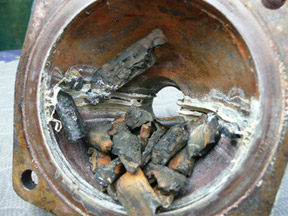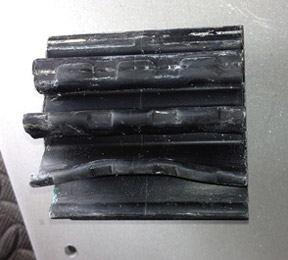Impeller Tips
Change Out That Seawater Impeller On A Regular Basis.
Why is it that we encourage owners to follow engine manufacturer’s directives, and change out seawater pump impellers on a regularly scheduled basis? Even if… “it has been working fine for years!”
Why? Because It will cost far less to change out an impeller once a year than to pay us for engine damage due to reduced sea water flow, because of blocked cooling journals due to broken and/or fragmented pieces of rubber blocking your cooling system. You can imagine how much time is involved in dismantling an entire raw-water cooling system! And, of course there is the high potential for over-heating damage as well.
What Happens: Rubber impellers last only so long before they start to break down due to exposure to seawater and wear.
Rubber Can Take a “set”: Additionally rubber blades tend to take a “set”. In other words, the impeller blades will acquire a fixed bend to the shape of the housing where the intake and out-take are located. This especially happens to pump impellers where a boat sits for long periods of time with no use.
Cracking And Then Breaking: Cracking typically starts at the base of the blades. An impeller can have cracked blades and still pump. However as the cracks continue to enlarge the pump will lose its ability to pump the proper volume of cooling water. Eventually these blades break off and more often than not become lodged anywhere in the raw water-side of the cooling system.
Wear Due to Use: Boats that do get a lot of use have impellers that through extensive use just plain wear out. These too though they may look fine upon inspection will have a reduced ability to pump the appropriate volume of water.
Silt Wear: A third issue that is not too much concern for those who cruise the Puget Sound, but anyone who cruises in tributaries where there is a measurable amount of silt will have issues of accelerated wear to the tips of the blades as such water is abrasive to the rubber.
How Often Should The Raw-Water Impeller Be Changed Out?
Well… Ask five mechanics, and you may get five different answers. We tend to encourage our clients to start with their engine manufacturer’s recommendation. Most all call for a once a year replacement. We tend to be guided by all manufacturers’ maintenance schedules.
Wear-Plate: Additionally, there is a wear plate at the base of the pump housing that should be inspected when the impeller is changed out. These typically last many years in non-silted water.
To the right are photos with captions of situations we see on a yearly basis.



